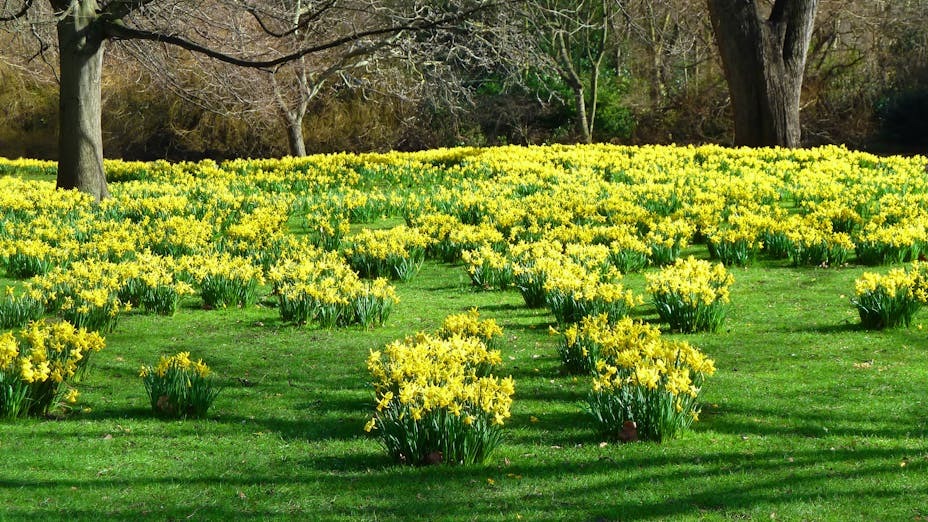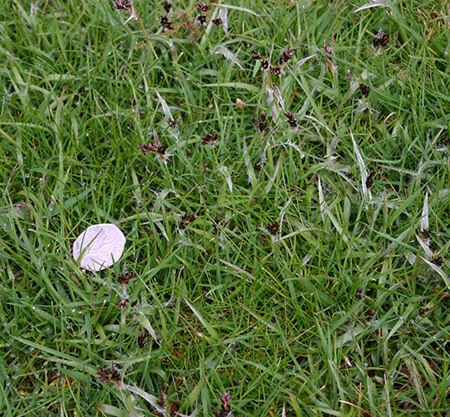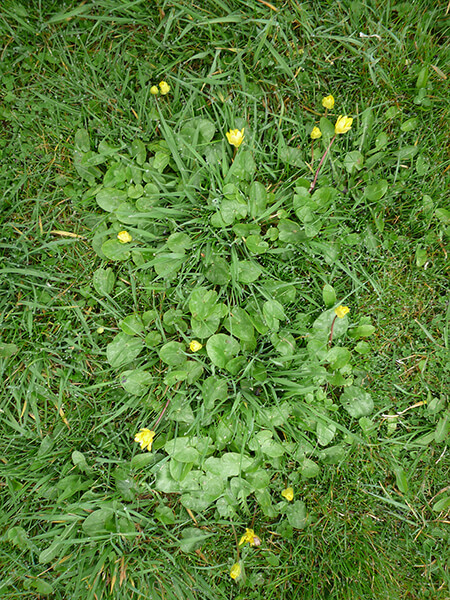
April 2024 Lawn Diary
Now that April is upon us, you’re just a few clicks away from getting up to speed with your spring lawn care!
With what felt like a never-ending winter continuing for most of March (which is now thankfully becoming a thing of the past), join us as we look at what lies ahead for this month and what to prioritise with the ins and outs of what tasks to complete in the garden this April!
This Month in a Nutshell
After a bit of unexpected winter weather carrying on into March this year, even though some areas were lucky enough to experience a bit of sunshine here and there, most of us just seemed to have been getting rain, with occasional bouts of frost and some areas getting even more snow! But thankfully, as we move into April, we can try to forget about winter’s weather since it’s finally time to have some fun in the garden now that warmer weather is appearing…
Summary ‘to do’ list for now through April:
- Moss Control
- Fertilising
- Aeration - Spiking only
- Raking or light Scarifying
- Spot Weed Control only
- Top Dressing
- Repairs and Seeding
The Weather
Courtesy of the Met Office:
Monday 25th March - Wednesday 3rd April
Turning unsettled across the majority of the UK early next week as a couple of weather systems bring rain or showers to most areas, with strong winds in places and temperatures near to a little below normal for late March. Perhaps staying relatively drier in the north, with some wintry showers possible for northern Scotland on Monday. During the bank holiday weekend and the following week, unsettled or changeable weather remains the most likely outcome. All areas are likely to see further rain or showers at times, with some drier spells in between, but wet weather will tend to favour the southwest while northern parts remain a bit drier on average. Temperatures will probably continue near normal for the time of year.
Thursday 4th April - Thursday 18th April
During the first half of April, pressure will likely be higher than average to the north of the UK, with low pressure more likely to the west or southwest. This pattern tends to push the focus of unsettled weather further south than usual, with the highest rainfall most likely in the south of the UK. Conversely, northern areas tend to be drier than normal. Temperatures will probably be near average or slightly above overall, with any cooler interludes most likely in the north early in the period.
Did your Lawn Suffer in the Drought last Summer?
By the looks of our email inbox, we see a lot of poorly looking lawns that couldn’t be repaired in time before winter set in. To help you breathe some fresh life into your lawn and to ensure it’s looking stunning again in no time – head on over to our Lawn Trends section and take a look at our advice for the practice of using a wetting agent as a preventative in our article titled: How to Stop my Lawn Drying Out
What’s New?
In our new section Lawn Care Problems we have added dozens of new articles to help you care for your lawn. They answer many of the most common and not so common problems and questions you ask us on a day to day basis. Here are the latest articles added during the last few months:
New for this Lawn Diary
From the previous Lawn Diary
- Best Time to Kill Broadleaf Weeds in the Lawn
- Best way to Kill Weeds in the Lawn
- No Mow May. Is it a Hoax?
Lawn Trends - A MUST Visit
Please visit the most important and current seasonal articles in our Lawn Trends area.
Mowing the Lawn
If you haven’t managed an initial cut yet, try to get on to it sooner rather than later, as April can be a warmer, wet month, which will speed up growth but make mowing difficult. Keep the mowing height on the high side until May unless you’re raking or scarifying, and then you’ll need a fairly low cut.
A few early mowing tips:
- Mow in the afternoon to allow the grass daytime drying time
- Keep the cut on the high side until you get to a more frequent mowing pattern
- Be careful with the turns as the ground can be soft
- Thoroughly clean the mower - wet grass sticks under the mower
Mowers
For the mowing season, you need to do two things: keep it clean and keep it sharp, so starting off with sharp blades in the spring is best but, alas rare! If the grass is damp, it can easily build up inside the mower, so always give the mower a good brush, scrape or hose down after every use. Secondly, if you do a lot of mowing, then be prepared to sharpen or swap blades mid-year to maintain a clean cut. Order your spare blade now before the shelves are empty!
Fertilising the Lawn
This is the month to get your spring lawn feed into the lawn. The demands of the winter will have taken their toll, and a spring feed is critical for a healthy lawn. Your timing will depend on how things are warming up in your part of the world. If you’re doing any other lawn maintenance such as moss control and raking or scarifying, then put your lawn fertiliser in afterwards. Your weed control should be done after fertilising, preferably in May or even June.
There are a variety of Lawnsmith® Fertilisers that can be applied at this time of year. The choice is simple and based on your soil and your enthusiasm for lawn care.
FAQ What fertiliser should you use when overseeding an existing lawn? Normally, you use the fertiliser appropriate to your soil type, but when over seeding you need to help the new seedlings and your existing lawn, so in this instance, use a neutral fertiliser such as Spring & Summer Natur or either of the Lawnsmith fertilisers for sandy soil. This is because there is a much wider range of nutrients in these fertilisers suitable for both young and established grasses.
Spreading Fertiliser Videos Spraying Videos View Fertiliser Range
Weed Control
Woodrush

Celandine

Once things start to warm, the more common weeds, such as dandelion will quickly appear though Woodrush and Celandine are now very obvious. Digging them out is about the only sure fire way of controlling them. See Weed Identification for more detail and control methods.
Don’t start applying weed killer to the whole lawn just yet, as many more weeds will come through over the next month or so. Plan on treating individual weeds with a Ready to Use Weed Killer or manually removing any obvious large weeds now. If there are too many, treat the whole lawn at the end of April or into May about two or more weeks after fertilising.
Watch the Video See Weed Killers
Moss Control
This winter has been fairly wet and dull, so a lot of moss about so this is where a lot of your effort should go if your lawn has suffered from heavy moss infestations. If you’ve been following our Moss Control Advice and the Lawn Diary, you’ll be up to speed with your lawn care programme. We did add an article to Lawn Care Advice last month based on what you were telling us up and down the country: not only did you confirm serious problems with moss, but many were experiencing quite severe thinning of the grass. Here’s the link to the article in case you missed it last month: Spring Lawn Repairs
This month is the best month for attacking the moss as the grass will soon be growing well. If you are just applying a ferrous sulphate based moss killer to control moss growth, then you can get on with it sooner rather than later, but after you’ve done a medium to high cut on the lawn. This means you won’t need to mow for a while after application, and you’ll have uncovered some moss, giving you better exposure to your treatment.
If, on the other hand, you’re going the whole hog and raking the moss out, your plans should include applying an iron or ferrous sulphate based Moss Killer, over seeding bare patches or even the whole lawn with appropriate grass seed and finally assisting recovery with fertiliser. See Scarifying & Raking for procedures. Raking in even early May is perfectly acceptable as long as there is ground moisture available for grass recovery.
Don’t forget you don’t HAVE to kill the moss before raking it out, as applying a ferrous sulphate based moss killer after raking to kill what remains will be more effective. Treating before AND after is even more effective, particularly if moss loves your lawn, but you need at least three to four weeks between applications with cool, wet conditions. See Moss Removal.
For those of you with concerns for the safety of children and pets that are likely to be on the lawn soon after treating, you can now use a chemical-free product in your treatment program. See MossOff in the moss killer products link below.
TIP: Good moisture levels around the grass and moss, such as on a dewey morning, helps the ferrous sulphate penetrate deeper. If there is no dew and the moss is dry, then just give it a quick squirt with the sprinkler by walking up and down the lawn and carrying it. It just needs a little damping.
Watch the Video Moss Killer Products
Watering the Lawn
Only if you have put grass seed or turf down, if moss needs a little wetting prior to spraying with ferrous sulphate or if it is dry after raking or scarifying.
Aeration & De-compaction
Any form of lawn aeration is pretty much in order in April. This may be slitting, spiking or hollow tining. If you are using a hollow tine aerator, do it sooner rather than later, as the large holes help the lawn warm and drain. This can be a problem if the weather becomes warm and dry, causing the lawn to lose too much water. My cut-off for hollow tine aeration here in Yorkshire is mid to end of April, so if you are in southern England early to mid-April and perhaps early May for Scotland.
As discussed in Lawn Aeration Advice, aeration is highly beneficial if done properly. Using lawn aerators such as a rolling aerator or aerator sandals makes it relatively easy. At the least, you should be looking to use a hollow tine fork on the most trafficked areas around clothes lines, path-to-lawn entry points, kid’s goal mouth and postman’s shortcut. Add grass seed to worn areas after aeration, and then fertilise the lawn.
Raking & Scarifying
This is the perfect time to get out the lawn raker or manual raker scarifier to remove old, dry grass or moss. Remember that raking uses wire tines, whereas scarifying uses blades. This means raking is unlikely to cause much damage, whereas scarifying, if done in a hurry, will cause damage just at the time when weeds become numerous. If possible, use spring for raking and light scarifying, with autumn being the best time to really get stuck in to scarify and de-thatch the lawn. If the lawn is thin or has bare patches, particularly if the moss was bad, get some grass seed before nature puts in weed seeds! You can read how to do this properly in Over Sowing with New Grass Seed
Watch the Video See the Scarifier
Repairs & Renovations
Any and all lawn repair and renovation jobs can be done now. If you are planning on doing any turfing this is the end of the turfing period. Any turf laid after this month will require regular watering to establish.
Pests & Diseases
Early spring is often a disease free time for lawns with red thread only occurring as humidity levels rise from May onwards.
Your main problems this month will be worm casts
Worms: Though it’s best to treat for worms at the first sign, they will continue to surface throughout the winter and produce muddy casts that cause mowing problems in the spring. Worms are beneficial in that they digest organic matter, provide nutrients, and enrich the soil. They also do some valuable aeration. A lawn with worms is generally far healthier than one without. Though only moderately reliable, we still feel Ferrous Sulphate is the most cost effective way to reduce worm casting.
Rolling the lawn
Consider this appropriate for the finest of lawns to consolidate any areas raised by worm activity and frost heave. Do this any time from now into May on relatively firm ground (not soft). Please note that rolling will not level a lawn, top dressing will.
Top Dressing
Top dressing is an advanced lawn care procedure that reduces thatch and smoothens the lawn’s surface. If you are not a lawn nut, then I suggest you don’t bother!
If you are, then as soon as you’ve got some good grass growth lower the mowing height prior to putting in your first top dressing. Application rates and frequency will vary depending on your goals and type of lawn so please read our top dressing advice.
The New Lawn
This is a great time to create a new lawn with grass seed or turf. With warmer temperatures on the horizon, the seed will germinate quickly. Getting seed in or turf down now, hopefully with the aid of spring showers is an opportunity not to be missed.
Thanks for visiting the Lawn Diary
Have a great month